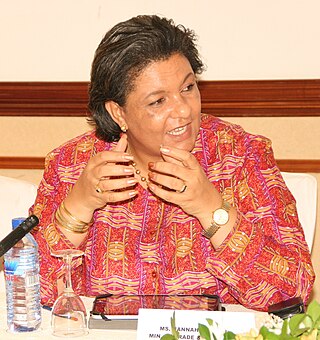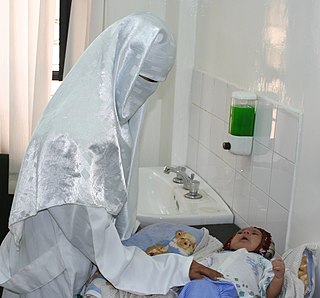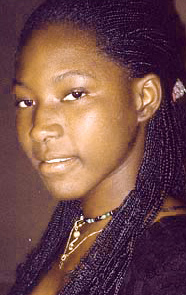
Female genital mutilation (FGM), also known as female genital cutting, female genital mutilation/cutting (FGM/C) and female circumcision, is the ritual cutting or removal of some or all of the external female genitalia. The practice is found in some countries of Africa, Asia and the Middle East, and within their respective diasporas. UNICEF estimated in 2016 that 200 million women in 30 countries—Indonesia, Iraq, Yemen, and 27 African countries including Egypt—had been subjected to one or more types of female genital mutilation.

Wangarĩ Muta Maathai was a Kenyan social, environmental, and political activist who founded the Green Belt Movement, an environmental non-governmental organization focused on the planting of trees, environmental conservation, and women's rights. In 2004 she became the first African woman to win the Nobel Peace Prize.
The Green Belt Movement (GBM) is an indigenous grassroots organization in Kenya that empowers women through the planting of trees. It is one of the most effective and well-known grassroots organisations addressing the problem of global deforestation. Professor Wangari Maathai established the organization in 1977 under the auspices of the National Council of Women of Kenya (NCWK). GBM's successes in forest conservation, education, and women's economic empowerment have gained the organisation worldwide acclaim. It is also noted for its advocacy of human rights, democratisation of access to public lands, and environmental justice issues such as the role of women's traditional ecological knowledge in addressing environmental degradation and desertification.
In the early 1960s, an interest in women and their connection with the environment was sparked, largely by a book written by Esther Boserup entitled Woman's Role in Economic Development. Starting in the 1980s, policy makers and governments became more mindful of the connection between the environment and gender issues. Changes began to be made regarding natural resource and environmental management with the specific role of women in mind. According to the World Bank in 1991, "Women play an essential role in the management of natural resources, including soil, water, forests and energy...and often have a profound traditional and contemporary knowledge of the natural world around them". Whereas women were previously neglected or ignored, there was increasing attention paid to the impact of women on the natural environment and, in return, the effects the environment has on the health and well-being of women. The gender-environment relations have valuable ramifications in regard to the understanding of nature between men and women, the management and distribution of resources and responsibilities, and the day-to-day life and well-being of people.
African feminism is a type of feminism innovated by African women that specifically addresses the conditions and needs of continental African women. African feminism includes many strains of its own, including Motherism, Femalism, Snail-sense Feminism, Womanism/women palavering, Nego-feminism, and African Womanism. Because Africa is not a monolith, these feminisms are not all reflective of the experiences African women have. Some of the feminisms are more specific to certain groups of African women. African feminism is sometimes aligned with, in dialogue or in conflict with, Black Feminism or African womanism as well as other feminisms and feminist movements, including nationally based ones, such as feminism in Sweden, feminism in India, feminism in Mexico, feminism in Japan, feminism in Germany, feminism in South Africa, and so on.

The status of women in Ghana and their roles in Ghanaian society has changed over the past few decades. There has been a slow increase in the political participation of Ghanaian women throughout history. Women are given equal rights under the Constitution of Ghana, yet disparities in education, employment, and health for women remain prevalent. Additionally, women have much less access to resources than men in Ghana do. Ghanaian women in rural and urban areas face slightly different challenges. Throughout Ghana, female-headed households are increasing.
The role of women in Egypt has changed throughout history, from ancient to modern times. From the earliest preserved archaeological records, Egyptian women were considered equal to men in Egyptian society, regardless of marital status.

The term "woman" generally refers to an adult human female. However, the concept of what it means to be a woman is complex and multifaceted, and has been subject to much discussion and debate in fields such as gender studies, feminism, and sociology.

The status and social roles of women in Mali have been formed by the complex interplay of a variety of traditions in ethnic communities, the rise and fall of the great Sahelien states, French colonial rule, independence, urbanisation, and postcolonial conflict and progress. Forming just less than half Mali's population, Malian women have sometimes been the center of matrilineal societies, but have always been crucial to the economic and social structure of this largely rural, agricultural society.

Women in Yemen have historically been placed at a disadvantage due to their gender, with a highly patriarchal society. Although the government of Yemen has made efforts that will improve the rights of women in Yemen, many cultural and religious norms, along with poor enforcement of this legislation from the Yemeni government, have prevented Yemeni women from having equal rights to men.

Women in Chad, a landlocked country in Central Africa, are the mainstay of its predominantly rural-based economy and they outnumber the men. Chad is a country with diverse and rich cultural practices, such as male beauty pageants and long-kept-secret hair products. Despite their numbers in the general population, there are very few women in governmental positions and gender equality is far from being a reality in Chad. Chad is rated as the third worst country in Africa for gender equality by the World Bank. Additionally, there are few women who reach higher education, and many who receive a college degree do so outside of the country.

Sudan is a developing nation that faces many challenges in regard to gender inequality. Freedom House gave Sudan the lowest possible ranking among repressive regimes during 2012. South Sudan received a slightly higher rating but it was also rated as "not free". In the 2013 report of 2012 data, Sudan ranks 171st out of 186 countries on the Human Development Index (HDI). Sudan also is one of very few countries that are not a signatory on the Convention on the Elimination of All Forms of Discrimination Against Women (CEDAW).

Sierra Leone, officially the Republic of Sierra Leone, is a Constitutional Republic in West Africa. Since it was founded in 1792, the women in Sierra Leone have been a major influence in the political and economic development of the nation.

The culture, evolution, and history of women who were born in, live in, and are from the continent of Africa reflect the evolution and history of the African continent itself.

Leyla Hussein is a Somali-born British psychotherapist and social activist. She is the founder of Dahlia project, one of the co-founders of the Daughters of Eve non-profit organization and a Chief Executive of Hawa's Haven. In 2020, Hussein was elected Rector of the University of St Andrews, making her the third woman and first woman of colour to hold this position.
KMG Ethiopia, also known as Kembatti Mentti Gezzima-Tope, is an indigenous non-governmental charitable organization based in Kembata, Ethiopia, dedicated to protecting women's rights, fostering women's health and supporting the environment. Founded in 1997 by sisters Bogaletch and Fikirte Gebre, the organization has expanded across the nation.
Female genital mutilation (FGM), also known as Female circumcision or Female Genital Cutting (FGC) in Nigeria accounts for the most female genital cutting/mutilation (FGM/C) cases worldwide. The practice is customarily a family tradition that the young female of the age 0-15 would experience. It is a procedure that involves partial or completely removing the external females genitalia or other injury to the female genital organs whenever for non-medical reasons.
Editar Adhiambo Ochieng is a Kenyan activist and feminist who advocates for women's rights and supports survivors of sexual violence. In 2020, Ochieng became the first winner of the Wangari Maathai Award in Kenya for her contribution to curb the spread of COVID-19 pandemic in the Kibera slum.
Rugiatu Turay is a Sierra Leonean women's rights activist. who is a staunch campaigner against female genital mutilation. She is the founder of The Amazonian Initiative Movement, a nonprofit organization with the main objective of eliminating the cultural practice of female genital mutilation in West Africa.
Asha Ismail is a Kenyan human rights activist. She is the founder and president of Save a Girl, Save a Generation, an organisation whose mission is to end female genital mutilation, the dowry system, forced marriage and other abuses against women in Africa and Asia.















